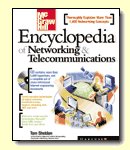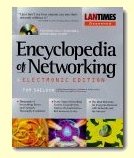|
Site home page
(news and notices)
Get alerts when Linktionary
is updated
Book updates and addendums

Get info about the Encyclopedia of Networking
and Telecommunicatons, 3rd edition (2001)

Download the electronic version of the Encyclopedia
of Networking, 2nd edition (1996). It's free!
Contribute to this site
Electronic licensing info
|
|
Web Caching
Related Entries Web Links New/Updated Information
Note: Many topics at this site are reduced versions of the text in "The Encyclopedia of Networking and Telecommunications." Search results will not be as extensive as a search of the book's CD-ROM.
The purpose of caching is to reduce latency and network traffic. Caching has been used for local storage since nearly the dawn of computers. Recently accessed information is stored in a cache buffer in case the user needs to access it again. If so, the data is pulled from the cache rather than the slower hard drive. Thus, latency is reduced.
On the Web, latency and traffic are reduced if previously accessed information can be obtained from a local or nearby cache server rather than from the Web server that originated the requested information (called the "origin" server). The information may be stored on the user's local computer, a special caching server within the enterprise, or a caching server geographically closer to the enterprise, usually at a nearby Internet service provider.
This topic continues in "The Encyclopedia of Networking and Telecommunications" with a discussion of the following:
- Hierarchical caching methods (see book for illustration)
- Local Web browser caching
- Proxy server caching
- Reverse proxy cache
- Distributed content servers (i.e., content distribution)
- Cache effectiveness (hit rates, freshness, and staleness)
- Techniques for improving cache effectiveness
- Proxy servers and caches
- Transparent caching and load balancing
- Cache arrays and caching proxy meshes
- Interproxy communication protocols
- ICP (Internet Cache Protocol)
- HTCP (Hyper Text Caching Protocol)
- Cache digest
- Cache prefilling
- CARP (Cache Array Routing Protocol)
- Network element communication protocols
- WCCP (Web Cache Control Protocol)
- NECP (Network Element Control Protocol)
- SOCKS
IETF Working Groups and RFCs
The following IETF working groups are working on Web caching and related protocols. You'll find working drafts and RFCs listed at the Web sites.
The following RFC provides additional information about caching and replication:
- RFC 2109 (HTTP State Management Mechanism, February 1997) describes HTTP's cookie mechanism. While not a form of caching as described here, Web servers use cookies to cache information about user sessions that can be used during subsequent visits to the site.
- RFC 2227 (Simple Hit-Metering and Usage-Limiting for HTTP, October 1997) describes a "Meter" header, which permits a limited form of demographic information (colloquially called "hit-counts") to be reported by caches to origin servers. It also permits an origin server to control the number of times a cache uses a cached response, and outlines a technique that origin servers can use to capture referral information without "cache-busting."
- RFC 2334 (Server Cache Synchronization Protocol-SCSP, April 1998) describes SCSP, a protocol that preserves cache information in a redundant server environment. It attempts to solve the cache-synchronization/cache-replication problem, which occurs when a group of servers wishes to synchronize information in their caches about the state of clients being served.
- RFC 2608 (Service Location Protocol, Version 2, June 1999) describes a protocol that helps network clients to discover the available services on a network and learn information about the configuration of those services. SLP can be used to locate caches. See "SLP (Service Location Protocol)."
- RFC 2616 (Hypertext Transfer Protocol - HTTP/1.1, June 1999) provides full details on how caching is implemented on the Web and, in particular, in Web browsers.
- RFC 3040 (Internet Web Replication and Caching Taxonomy, January 2001) specifies standard terminology and the taxonomy of web replication and caching infrastructure with the goal of establishing a common understanding of the technology.
Copyright (c) 2001 Tom Sheldon and Big Sur Multimedia.
All rights reserved under Pan American and International copyright conventions.

|

